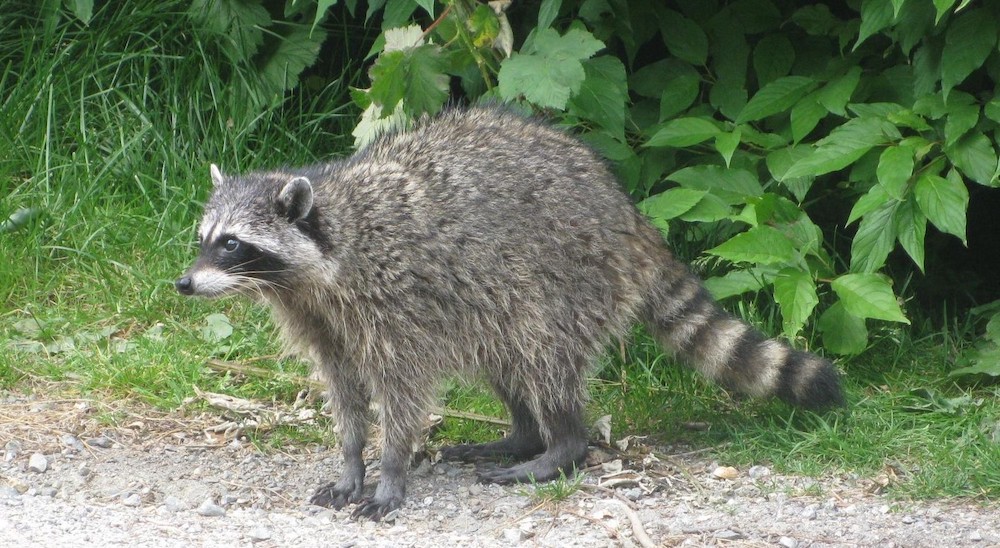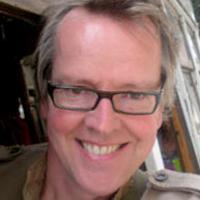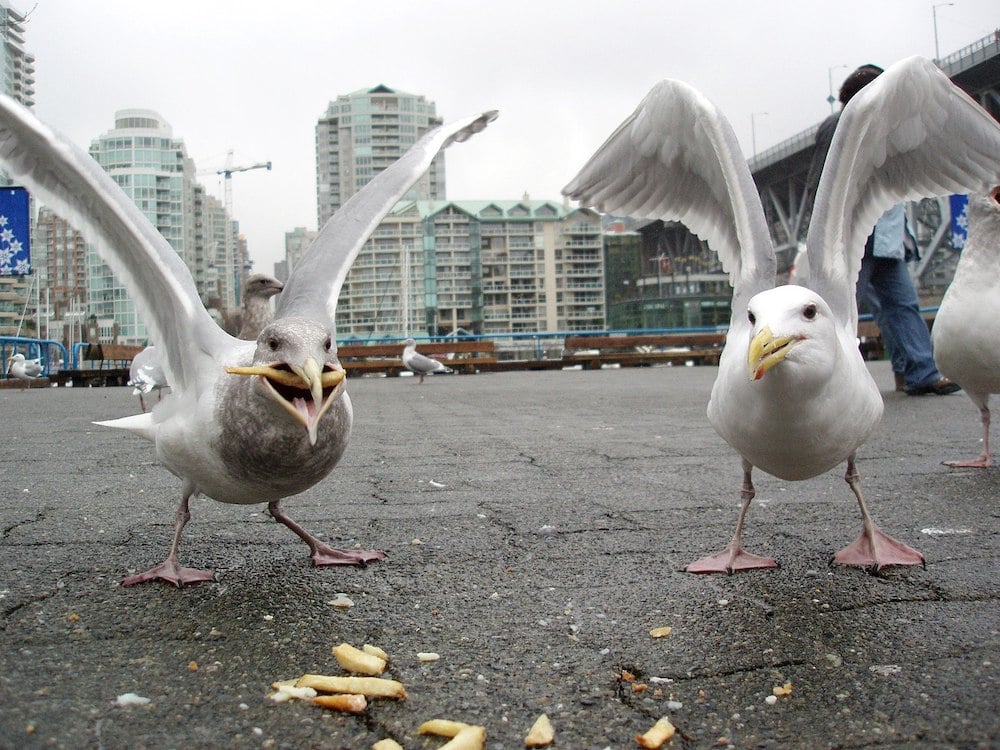We share our neighbourhoods with a variety of creatures that have become habituated to human contact, including soggy human fries and stale human bagels. While pandemic assistance programs have been put in place for many of us — subsidies, rent rebates, emergency funds — the pigeon economy must surely be imploding. How is urban wildlife affected by the absence of restaurant garbage and scraps? Might we see population crashes among big city birds and animals?
According to UBC's Edward Kroc, the birds at least should be fine. “I'm pretty skeptical that any populations will noticeably decline due to the lack of human activity in and around the city,” says Kroc, an assistant professor in the Department of Educational and Counselling Psychology and Special Education. “In fact, I wouldn't be surprised to see a mild bump upwards for some species.”
Kroc, who has done extensive studies on urban gull populations, cites a couple of reasons for believing the big city birds will glide through this. “We are still producing just as much waste and trash as we always have,” he says. “It's just appearing in different forms. So maybe there's less trash on the beach, but there will be more trash in our home garbage bins and our landfills. Our urban species that scavenge trash are very smart and shouldn't have much of a problem finding/accessing these shifted locations.”
Zoologist Dr. Sarah Benson-Amram, currently at the University of Wyoming but planning to join the UBC faculty next year, thinks animals like raccoons will do fine, as well. “We have some preliminary data showing us that urban raccoons are very flexible in their diet,” she says, “and that the diets of urban raccoons can vary greatly depending on which food is most readily available in the immediate area.”
“Within the animal cognition field, there is a popular hypothesis called the cognitive buffer hypothesis,” Benson-Amram says. “It states that those species that are most flexible in their behaviour when the environment changes will be the most successful in urban environments. So, it is possible that even individuals that commonly eat human food will be able to switch their behaviour and eat more natural prey items when the prevalence of human food decreases. Or it is also possible that individuals will be able to alter their behaviour and find other sources of human food that are still available when the sources they had been relying on become less accessible.”
Plus, those of us who magnanimously toss crumbs to local birds or cold fries to raccoons may not be quite as essential to their well-being as we might like to think. We are more likely to find ourselves in the position of recently-dumped boyfriends, devastated to discover their partners can indeed carry on without them. “There's very little evidence that I'm aware of that any species rely on handouts from humans to survive and thrive in the urban environment,” Kroc says. “Such species are opportunistic; they'll take advantage of anthropogenic food sources when they are available, but rarely abandon more natural sources, especially because these natural sources are usually of much higher quality.”
And what about rats? “Hungry rats are going to do whatever they have to do,” The Tyee quoted a New York rodent expert in a recent story. “Once the food goes away, then all bets are off as to how mammals are going to behave.” While the diets of most urban rats are 80 per cent vegetarian, a hangry rat has “been known to snatch hatchlings from the nests of songbirds or stalk pigeons and attack from behind.”
The bigger the city, the meaner the streets. And this month in New York, the rat race is getting very real. News reports have said desperate rodents accustomed to restaurant garbage are now turning to cannibalism and vicious turf battles.
Is the clash coming here? Mike Londry has seen a lot of rattus norvegicus in his ten years running West Side Pest Control. (The gnarly-looking Norwegian rat, Londry says, has largely taken over from rattus rattus, the somewhat cuter roof rat that once ruled the roosts around here.) “We're not the same as New York,” Londry says, pointing out that the lack of alleys in New York means restaurant garbage is bagged on the streets, making them rat heaven. But with its abundance of waterfront, Vancouver is a rat-friendly environment too. “Wherever you find water, you'll find rats,” he says.
And rats that have been living by the water or in residential areas might find themselves facing new competition from roving rats that had been feasting on restaurant dumpsters. The resulting rat vs. rat battles could even do Londry's job for him. “Rats might reduce the rat population,” he says. “In the past three weeks our rat calls have diminished by about 43 per cent.”
That may reflect a change in the firm's advertising as West Side Pest Control has begun emphasizing ant and wasp control (easier to do while maintaining social distancing). But it could mean that the rats are turning on each other. “They'll kill each other,” Londry says. “Rats have no problem with that.”
Dr. Benson-Amram says larger mammals, too, are likely to roam beyond their usual comfort zones in search of a morsel. “It is highly likely that individuals with specific sources of human food within their home range are having a more difficult time if those food sources are no longer available,” she says, “and this can increase competition between individuals for the sources that remain accessible.”

Anecdotal reports suggest that at the very least animals are taking advantage of quiet streets to stretch their furry legs. On social media, kangaroos are shown hopping down Aussie avenues and bears strolling in Italian piazzas.
Not that this is likely to be a good thing for our animal friends. Even when humans are not actively trying to exterminate urban animals, wildlife can suffer from the interactions. Kroc suggests the downside to feeding local birds may be as great as any immediate benefits. “Human feeding can increase the incidence of disease and parasite transmission in some species,” Kroc says, “for example, when people fail to keep their feeders clean.”
There is currently a lot of focus on transmission of disease from animals to humans — bats being the villains of the moment — but transmission happens the other way too. It's not so much that animals catch flu or the sniffles from us, but from our pets. Canine distemper has devastated Vancouver animal populations in the past, crashing populations of raccoons and skunks. “We see frequent fluctuations of populations of urban wildlife due to diseases, such as distemper,” Benson-Amram says. “These can be quite devastating in the short term, but urban wildlife populations often rebound over the long term.”
This spring may prove to be an interesting period of observation for urban ornithologists. “Here in the Lower Mainland, I am very curious to see what happens throughout this year's breeding season which is just starting,” Kroc says. “I would guess that less human disturbance will lead to higher reproductive success rates for many species — for example, tree, shrub, and ground-nesters that would otherwise be disturbed by people. Decreased automobile traffic also means there will probably be fewer road fatalities of unfledged chicks.”
(The idea that a reduced human presence may lead to greater reproductive success is anecdotally borne out by the recent panda shenanigans at a deserted Hong Kong zoo.)
“I would also speculate that less marine traffic could lead to healthier forage fish populations in the Salish Sea,” Kroc says. “In turn, this could translate to healthier food for parents and chicks, and so better reproductive success. Fewer people — and fewer dogs — on our beaches could also mean more useable nesting habitat for important shorebirds with small populations, like the black oystercatcher.”
Kroc even suggests that any negative consequences for urban birds this spring may result from more human attention rather than less. “Some potential negative effects we could see are since people will be at home more, they may become more aware of their non-human neighbours,” he says, “and this could lead to more conflict.”
Kroc is thinking particularly of seagulls here — rarely the favourite fowl of local pedestrians, but a focus of much of his own research. “I spend a lot of time tracking where our urban gulls nest in and around the city, and they can be quite loud when they do nest,” he says. “If that happens right next to someone's window, this could create problems with people not respecting that these native species have a federally and provincially protected right to be there, and to nest wherever they please.”
We may in fact be facing human-gull warfare, if the East Riding of Yorkshire Council in England is correct. It has issued a public bulletin advising coastal residents that "due to a lack of food sources, seagulls may be more hungry than normal and may behave aggressively.”
There is still time to step back from the brink, Yorkshire Council insists. If everyone will just “stay home, stay safe — don't eat on the seafront promenades and beaches,” such measures may “encourage the birds to fend for themselves away from towns.”
There could even be a silver lining. “If we have a generation of young birds who have not relied on human food,” pronounces the council, “we may be able to break the cycle and people will be able to eat on the seafront without being ‘mugged’.”
Gulls that spurn French fries? It's a crazy utopian vision. But in these difficult times we must dare to dream. ![]()
Read more: Coronavirus, Environment
















Tyee Commenting Guidelines
Comments that violate guidelines risk being deleted, and violations may result in a temporary or permanent user ban. Maintain the spirit of good conversation to stay in the discussion.
*Please note The Tyee is not a forum for spreading misinformation about COVID-19, denying its existence or minimizing its risk to public health.
Do:
Do not: